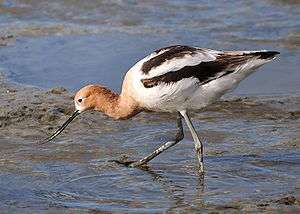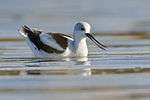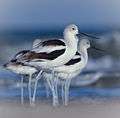American avocet
| American avocet | |
|---|---|
 | |
| Breeding plumage | |
| Scientific classification | |
| Kingdom: | Animalia |
| Phylum: | Chordata |
| Class: | Aves |
| Order: | Charadriiformes |
| Family: | Recurvirostridae |
| Genus: | Recurvirostra |
| Species: | R. americana |
| Binomial name | |
| Recurvirostra americana Gmelin, 1789 | |
 |
American avocet calls
Calls from American avocets in Palo Alto, California |
| Problems playing this file? See media help. | |
The American avocet (Recurvirostra americana) is a large wader in the avocet and stilt family, Recurvirostridae.
Description
This avocet has long, thin, gray legs, giving it its colloquial name, blue shanks. The plumage is black and white on the back with white on the underbelly. The neck and head are cinnamon colored in the summer and gray in the winter. The long, thin bill is upturned at the end. The adult bird measures 40–51 cm (16–20 in) in length, 68–76 cm (27–30 in) in wingspan and 275–420 g (9.7–14.8 oz) in weight.[2][3]
Breeding and habits
The breeding habitat is marshes, beaches, prairie ponds, and shallow lakes in the mid-west as far north as southern Alberta, Saskatchewan, and Manitoba,[2] and on the Pacific coast of North America. American avocets form breeding colonies numbering dozens of pairs. When breeding is over the birds gather in large flocks, sometimes including hundreds of birds. Nesting occurs near water, usually on small islands or boggy shorelines where access by predators is difficult. The female lays four eggs in a saucer-shaped nest, and both sexes take turns incubating them. Upon hatching, the chicks feed themselves; they are never fed by their parents.[4]
This species is migratory, and mostly winters on the southern Atlantic and Pacific coasts of Mexico and the United States.
The American avocet forages in shallow water or on mud flats, often sweeping its bill from side to side in water as it seeks its crustacean and insect prey.[4]
Protected status
The American avocet is protected under the Migratory Bird Treaty Act of 1918.[5]
Gallery
-

Winter plumage
-

Nesting
-

Nest with eggs
-

Eggs
-

Adult with a chick at Palo Alto Baylands Nature Preserve, California
-

Quintana, Texas. Summer
-

Quintana, Texas. Winter
References
- ↑ BirdLife International (2012). "Recurvirostra americana". IUCN Red List of Threatened Species. Version 2013.2. International Union for Conservation of Nature. Retrieved 26 November 2013.
- 1 2 "American Avocet, Identification". allaboutbirds.org. The Cornell Lab of Ornithology, Cornell University.
- ↑ "American Avocet". seaworld.org. SeaWorld.
- 1 2 "American Avocet Fact Sheet, Lincoln Park Zoo" Archived July 19, 2011, at the Wayback Machine.
- ↑ Migratory Bird Treaty
- O'Brien, Michael, et al. (2006). The Shorebird Guide. New York: Houghton Mifflin. ISBN 0-618-43294-9
External links
| Wikimedia Commons has media related to Recurvirostra americana. |
| Wikispecies has information related to: Recurvirostra americana |
- American avocet - Recurvirostra americana - USGS Patuxent Bird Identification InfoCenter
- American avocet species account – Cornell Lab of Ornithology
- "American avocet media". Internet Bird Collection.
- American avocet photo gallery at VIREO (Drexel University)
- Interactive range map of Recurvirostra americana at IUCN Red List maps
